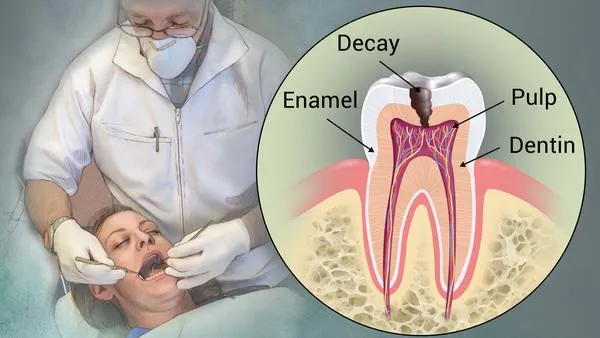
source
Hello everyone, @oghie here
Dental caries (cavities) are the most familiar form of oral disease known to man, and the means of getting caries is called tooth decay.
Tooth decay in other words is the annihilation of your tooth enamel -- the strong outer layer of your teeth. This progeny can also influence children, teens and adults. Plaque, an adhesive film of bacteria, is perpetually forming on your teeth. When you eat or drink foods or beverages which contains sugars, the bacteria in plaque produce acids that assault tooth enamel. The gumminess of the plaque keeps these acids in contact with your teeth, and over time the enamel can collapse, according to the American Dental Association (ADA)
The types of caries formed can be broken down into two major groups:
Pit and fissure caries: They are found most often on the chewing surfaces of the back (premolar and molar) teeth, and the back of the front which is anterior teeth. Your teeth are composed of diverse segments of the enamel, and where these sections meet, grooves and pits can trap plaque, causing decay. The appropriate application of pit and fracture sealants, a strong plastic material utilized to clinch the grooves and pits when the teeth have spurted, can avert this type of dental caries. The sealants also make it less likely that you will need fillings (restorations) on those surfaces of the teeth.
Smooth surface caries: These are found most frequently along the gum-line or where two teeth touch (or the space between teeth), if plaque forms in those zones. With the proper use of dental floss, you can avert most smooth surface caries in the inter proximal area, and using a toothbrush along the gum-line can avert caries in that area as well.

source
Oral Hygiene Tools and Preventive Products
There are many types of dental health aids available that can help you avert dental caries. A quality toothbrush that has the proper bristles and angulation to help discharge plaque is crucial. There are inexpensive power brushes available to help remove plaque more adequately. Colgate toothpaste has a broad selection of both manual and power toothbrushes. Your dentist can help you choose the best toothbrush for plaque removal.
The use of an ADA-approved toothpaste which contains fluoride is also an eminent way to prevent dental caries, as the fluoride in the toothpaste provides a protective coating that nullifies the acid attack caused by plaque. Once again, it's best to ask your dentist for an experienced recommendation.
During your routine checkup, your dentist can implement a thin coat of fluoride varnish to your teeth after the cleaning portion of your visit is finished. This varnish contains a concentrated form of fluoride, which when left on for an hour is amalgamated into the surface of your teeth, making the enamel and exposed root surfaces more immune to the acid attack from plaque. Fluoride varnish also reduces your teeth's sensitivity to cold and heat, and it can reverse caries that are just shaping by strengthening the layer of enamel and remineralizing the surface.
In conclusion, all thanks to these medical advancements, dental caries have seriously been reduced in children and adults. It is not exceptional to see patients to go through their lives without ever having a dental cavity. With accordant dental visits, good oral hygiene habits and a healthy diet, you may be able to go your entire life without facing the most common oral disease ever faced by man.